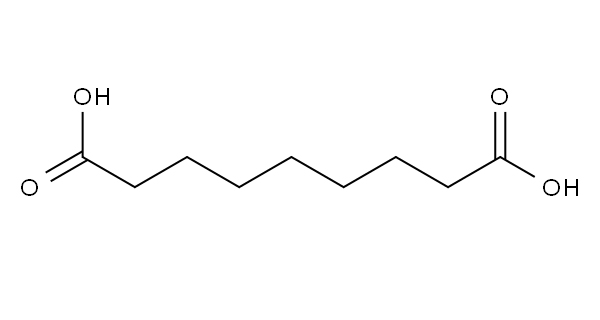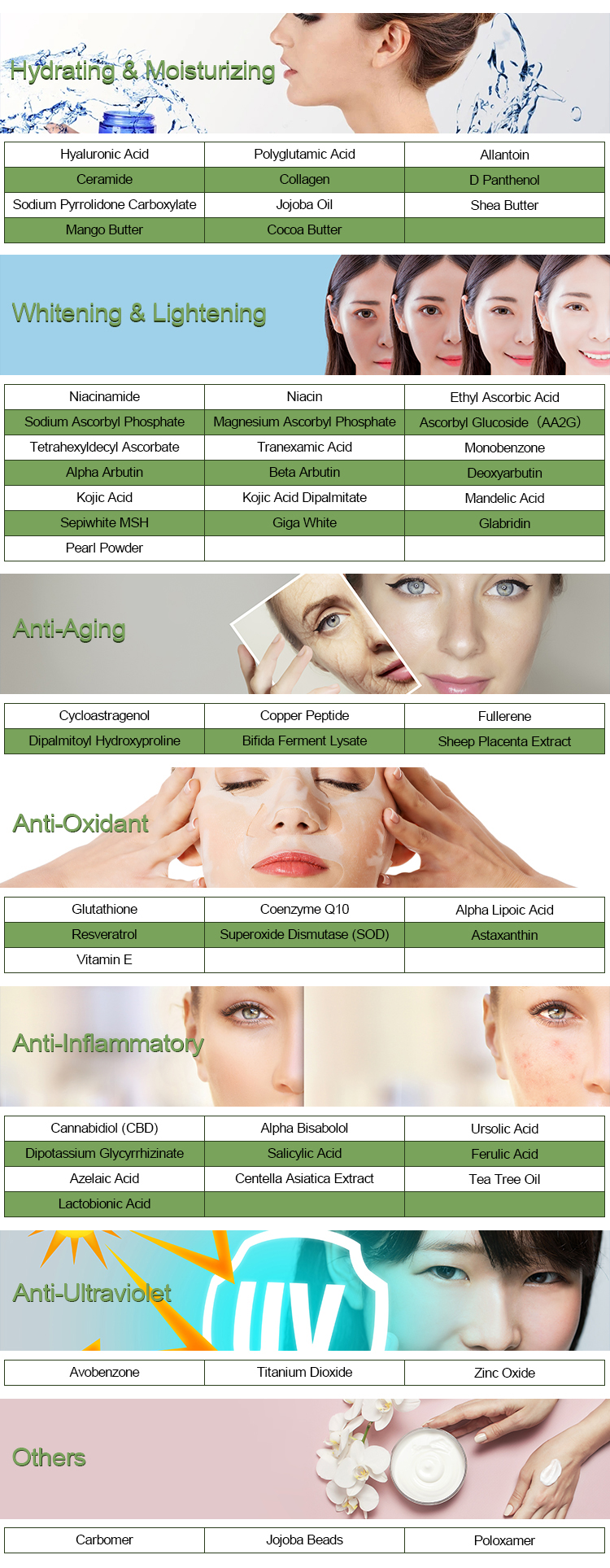Azelaic acid is a naturally occurring dicarboxylic acid that is primarily used in the pharmaceutical and skincare industries due to its beneficial properties. Here is some information about its chemical structure and physical properties:
Chemical Structure of Azelaic Acid:
1.Molecular Formula: C9H16O4
2.Chemical Structure:
- H2C(CO2H)(CH2)4CO2H
- The structure consists of a 9-carbon backbone with two carboxylic acid (CO2H) functional groups, which are separated by a chain of four methylene (CH2) groups.

Physical Properties of Azelaic Acid:
- Physical State: Azelaic acid is a white, crystalline powder at room temperature.
- Melting Point: Azelaic acid has a melting point of approximately 138-140°C (280-284°F).
- Solubility: It is sparingly soluble in water, but it is more soluble in organic solvents like acetone, chloroform, and diethyl ether.
- Odor: Azelaic acid is odorless.
- Density: The density of azelaic acid is approximately 1.29 g/cm³.
- Molar Mass: The molar mass of azelaic acid is approximately 188.22 g/mol.
- pKa: The pKa values for the two carboxylic acid functional groups in azelaic acid are around 4.4 and 5.5.
- Hygroscopicity: Azelaic acid is not hygroscopic, meaning it does not readily absorb moisture from the air.
- Stability: It is stable under normal storage conditions but may degrade upon exposure to heat, light, or oxidizing agents.
Azelaic acid has several important applications, including as a treatment for acne and rosacea due to its anti-inflammatory and antimicrobial properties. It is also used in the synthesis of polymers, and it has been investigated for its potential in various pharmaceutical and cosmetic formulations. Its unique chemical structure and physical properties make it a valuable compound for different industries.
How to use Azelaic Acid for best results?
Azelaic acid is a topical skincare ingredient known for its benefits in treating acne and hyperpigmentation, as well as its ability to improve skin texture and overall appearance. To use azelaic acid for the best results, follow these guidelines:
Start with a low concentration: If you’re new to azelaic acid, begin with a product that has a lower concentration (typically around 10%). This allows your skin to adjust and minimize the risk of irritation. You can gradually increase the concentration as your skin becomes accustomed to it.
Patch test: Before applying azelaic acid all over your face, perform a patch test on a small, inconspicuous area of skin to check for any adverse reactions or allergies.
Cleanse your skin: Begin with clean, dry skin. Use a gentle, pH-balanced cleanser to remove any makeup, dirt, and oil.
Apply a small amount: A little goes a long way. Apply a small amount (about a pea-sized or less) of azelaic acid to the affected areas of your face. You can use your fingers or a cotton pad to apply it.
Follow the recommended application frequency: Most azelaic acid products can be applied once or twice a day, but it’s essential to follow the specific instructions provided by the product manufacturer.
Use sunscreen: Azelaic acid can make your skin more sensitive to the sun, so it’s crucial to apply sunscreen with at least SPF 30 every morning, even on cloudy days. This helps protect your skin and prevent further hyperpigmentation.

Moisturize: After applying azelaic acid, wait a few minutes for it to dry, and then follow up with a moisturizer to keep your skin hydrated. This step can also help reduce potential dryness or irritation.
Be patient: It may take several weeks to see noticeable results. Azelaic acid works by promoting cell turnover and reducing inflammation, so improvements in acne, hyperpigmentation, and texture may be gradual.
Avoid overuse: Don’t use azelaic acid in combination with other strong active ingredients, such as retinoids or alpha hydroxy acids, without consulting a dermatologist. Overuse of potent ingredients can lead to irritation and damage to your skin’s barrier.
Discontinue use if irritation occurs: If you experience excessive redness, burning, or stinging, discontinue use and consult a dermatologist. You may need to adjust the frequency of application or switch to a lower concentration product.
Consult a dermatologist: If you have specific skin concerns or conditions that azelaic acid may help with, it’s a good idea to consult a dermatologist. They can recommend the right product and usage instructions tailored to your needs.
Overall, azelaic acid can be a valuable addition to your skincare routine, but it’s essential to use it carefully and be patient for the best results.
